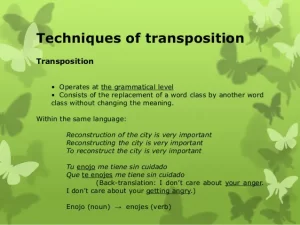The translators with his great experience and nature of experimenting things may use a variety of techniques to produce remarkable results in their work. The text in the target language can be improved and sound way better through a variety of methods. One of these techniques is known as ‘Transposition’. This term is very familiar to a lot of people, but here we will explain the transposition role in translation.
Transposition is considered to be the very first step or technique of oblique translation. However, oblique translation is the term used for free translation in which the translators have complete freedom of exercising to attain the equivalence. It is actually operating on the grammatical level consisting of the replacement of the word by another word without changing the meaning of that word. It has been elaborated from a stylistic point of view, that in fact the transposed expression, although have the same meaning but the value is not the same. They are considered to be more literary character. But the question is the importance to choose the best fitting form for the context.
However, the transposition can be;
- Free: It refers to the transposition that is mainly depending on the context and the desired effect particular to it. Take an example of the below mentioned term as back translation;
‘The course is of interest to all of us’ = ‘The course interest all of us’.
- Compulsory: It refers to the acceptability of the transposition that makes it necessary in any particular context. The example of the same be;
‘I will never forget that time when I saw you in the shopping Mall’ = ‘I will never forget the time that I saw you in the Shopping Mall’
There are different types of Transposition as explained below;
- Adverb: I just defended him.
Verb: I did nothing but defend him.
- Adverb: He called you early this morning
Noun: He called you at the beginning of the day.
- Adverb: She lives dangerously
Adjective: She lives a dangerous life
- Adjective: She found it difficult to learn for the test
Noun: She had difficulty learning for the exams.
- Possessive article: My hair is too long
Definite article: I have the hair too long
- Verb: He intends to give me a present.
Participle noun: His intention was to give me a present.
- Adverb: I wrote to him earlier this month.
Noun: I wrote to him at the beginning of this month.
Simply speaking, the transposition is the process of changing the sequence of the part of speech while translating. Take an Example of translating ‘blue ball’ into French, it will become ‘boule bleue’. It is in fact a shift of word class. Although, different languages have different grammatical structures. For Example, the translation of ‘He likes Swimming’ in German would be ‘Er scheimmt gern’. It has been observed that transposition is used in the translation of text from English to Spanish. Usually in English, the verb is in the beginning of the sentence.
The translator must know that the replacement of a word category in any target language has the possibility of altering the meaning of it in the text of the source language. Take an Example of, English to Spanish Translation of ‘hand knitted’ that becomes ‘tejido a mano’.


